|
On the 2nd October 1844, St.
George's Parish was created because the congregation at
St. Lawrence's had grown too large for the church.
In the same year St. George's Sunday School opened in
St. George's Street with room for 112 boys and 112
infants. It was another eight years before
sufficient funds were raised to build a church, so in
the meantime services were held in the Sunday school.
The church, built in Early English
style at a cost of around £2,500 was consecrated on 3rd
August, 1852. It had a nave in 5 bays, aisles, a
chancel, a tower containing a single bell, a church
organ by Walker of London, and seating
for 673 people.
The vicars were as follows:
| Rev. Manton Hathaway,
B.A. from 1852
until his death in 1878. |
| Rev. Joel Jones
from 1878 until his
death in 1884. |
| Rev. George Oliver,
B.A.
from 1885 until
1896. |
| Rev. Ernest Chattock,
M.A.
from 1896
until 1909. |
| Rev. C. E. Armitage, B.A. from
1909 until 1927. |
| Rev. Harry Gordon Davies,
B.A. from 1927 until 1929. |
| Rev. B. Paton Jones,
L.Th.
from 1930 until
1936 |
| Rev. Edward Taylor, A.K.C.
from
1936 until his death in 1962. |
| Rev. David Richard, B.A.
from 1962
until 1970. |
| Rev. Brynmor Jones, B.A.
from 1970
until the last service on 17th January, 1974. |
|
|
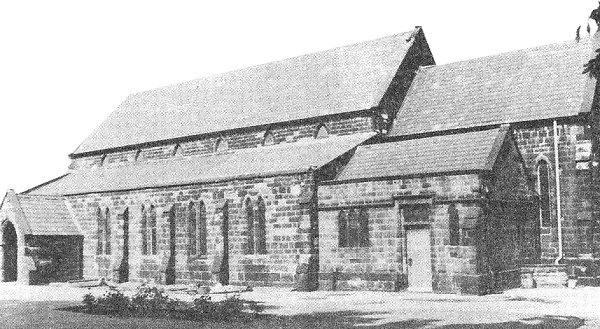
St. George's Church. |
|
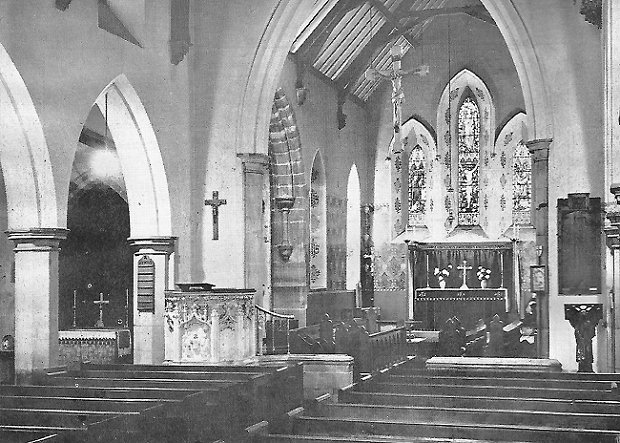
A fine view of the interior of
the church. Courtesy of John & Christine Ashmore. |
| The church and the garden
of rest. Courtesy of John & Christine Ashmore. |
 |
|
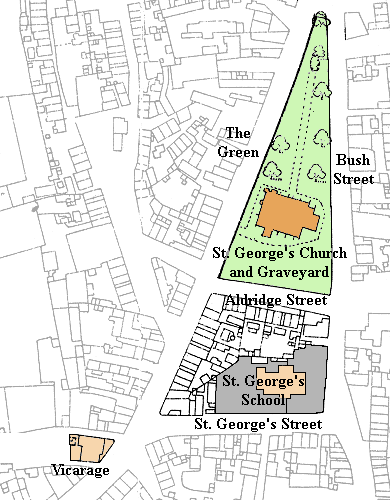
The location of the church,
the school, and the original vicarage. |
The original vicarage stood in The
Green opposite the Why Not pub. It was built in 1856 on
a piece of land given by George Addenbrooke of Addenbrooke, Smith & Pidcock,
better known as Rough Hay Furnaces.
The building costs
were paid from grants
and private contributions. George Addenbrooke became
churchwarden at St. George's, and on his death in 1906
was buried there.
Over one third of Darlaston's
population lived in Saint George's Parish. In 1881 there
were 3,875 occupants, which had increased to 4,212 by
1891.
The adjoining graveyard, originally enclosed by a
brick wall, opened in 1860. The first interment took
place on 22nd March.
In 1885 under the guidance of Rev.
George Oliver, a programme of building work began at the
church with the enlargement of the chancel and the
restoration of the building. The project, which cost
£550 included the building of the vestry, and the
installation of a water heating system.
|
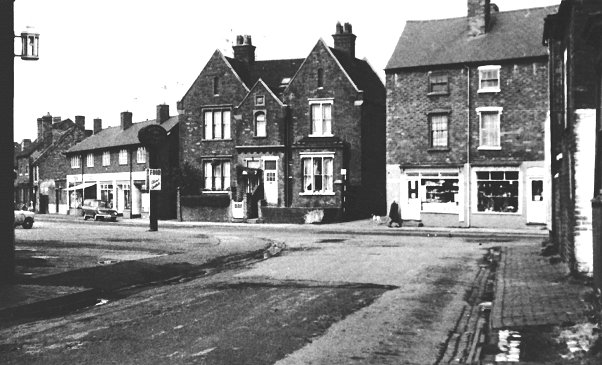
Looking into The Green from
St. George's Street. The building on the far side of
the road in the centre is the original vicarage. On
the far left is the Why Not pub. |
| The architect was C. Bryan Oliver of London and
Bath, and building work was carried out by G. P.
Butler of Darlaston, and Jones and Attwood of
Stourbridge. The church reopened in October of that
year. In 1890 George Oliver founded St.
George’s Social Club, and established a mission room
on the corner of Addenbrooke
Street, known as the Mission Hall of The Good Shepherd.
It was built at a cost of £650 and served by a licensed
lay evangelist. |
|
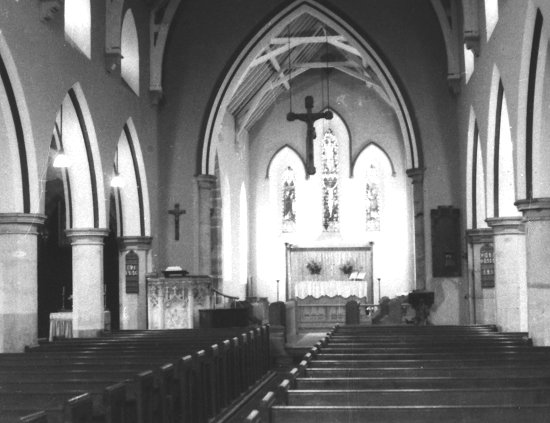
The interior of the church.
Courtesy of Howard Madeley. |
|
The school, which became Darlaston
Green Day School, was taken over by Darlaston School
Board in 1883, and known as St. George's Board School.
By 1887 it catered for 145 boys and 112 infants, and
remained in use as a board school until a replacement
board school was built in Willenhall Road. Although no
longer a day school, the building continued to be used
by the church for many years.
Further improvements were made to
the church in the 1930s. Between 1930 and 1931 the
north aisle was converted into a lady chapel, the school
buildings were repaired, and central heating installed.
In 1934 the church was again renovated. New carpets were
fitted in the sanctuary and aisles, the north-western
corner of the building became a children’s prayer area,
and improvements were made in the baptistry including
the installation of oak pillars for the screen.
In March 1934 the choirmaster John
Jones presented the church with a new vicarage which had
been built in Bush Street, opposite the church, on the site of some old
cottages. The Rev. B. Paton Jones was the first
occupant. He was followed by the Rev. Edward Taylor, who lived
there until his death in 1962.
Throughout its life the church had
many close links with local industry, particularly with
local factory owners. Church wardens included Samuel
Rubery, John Tunner Rubery, George John Garrington, and
George Addenbrooke. Industrial Sunday Services were
often held at the church during which sermons were
preached by Sir Alfred Owen, and his son David.
|
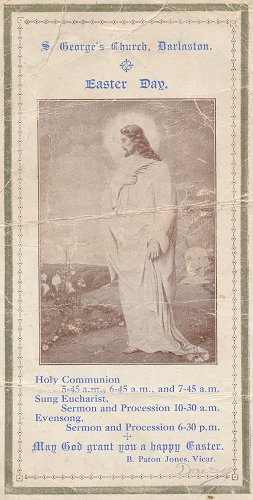
From the early 1930s. |

The new vicarage in Bush
Street. By the 1930s the original vicarage in
The Green, built in 1856 was no longer suitable
and so John Jones, the choirmaster, presented
the church with a new one. It was designed by
Joynson Brothers and built by T. Jones (Builders
Limited) of Darlaston. Building work began in
the summer of 1933 and was completed in March
1934. The gardens and the lawn were laid out by
Bakers Limited, Codsall. The first occupant was
the Rev. B. Paton Jones. The vicarage was
dedicated by the Bishop of Lichfield on the
evening of Tuesday, 8th May, 1934. |
|
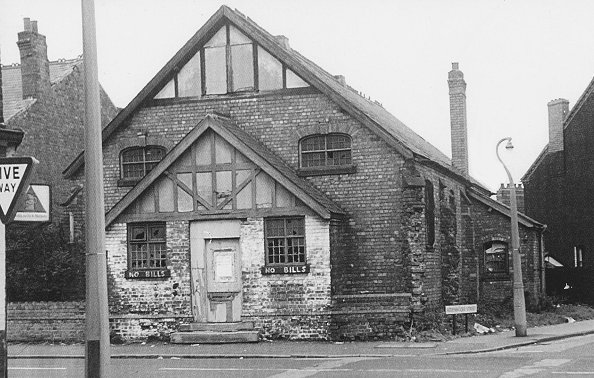
The Mission Hall of The Good
Shepherd. Courtesy of Tony Highfield. |
 |
|
 |
|
Two views of St. George's Church
from The Green. Photographed in the1930s by the late W. J. Ashmore. Courtesy of John &
Christine Ashmore. |
|
|

The Garden of Rest. |
| In 1954 the churchyard was laid out
as a garden of rest by Darlaston Council to commemorate
the coronation in 1953. A dedication ceremony took place
on 21st June, 1954. In December 1959 the statue of Saint
George and the dragon was erected on the northern corner of the
garden of rest to commemorate George John Garrington
J.P. who served at St. George's Church as churchwarden
and did much for the town. |

A newspaper article from a
newspaper cutting, newspaper and date unknown.
Courtesy of John & Christine Ashmore. |
|
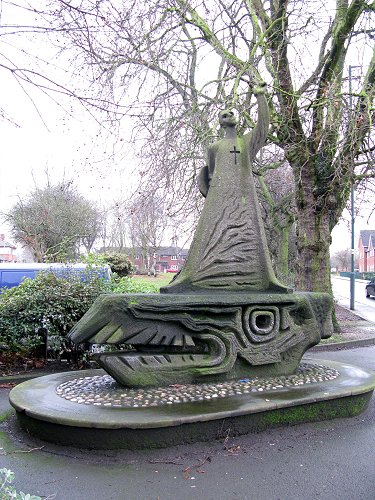
The statue of Saint George and
the dragon. |
The statue carries the
following inscription around the top of the base:
This Churchyard was laid out as
a Garden of Rest by Darlaston Urban District Council
assisted by public subscriptions during the
Chairmanship of Councillor A. G. B. Owen, C.B.E. to
commemorate the Coronation of Her Majesty Queen
Elizabeth II and was dedicated by the Lord Bishop of
Lichfield on 21st June, 1954.
To complete the beautifying of
this Garden of Rest this Statue was erected in
December 1959 and commemorates the late George John
Garrington, J.P. member of the Council for many
years and sometime Churchwarden of this Parish who
rendered many public services to this town. |
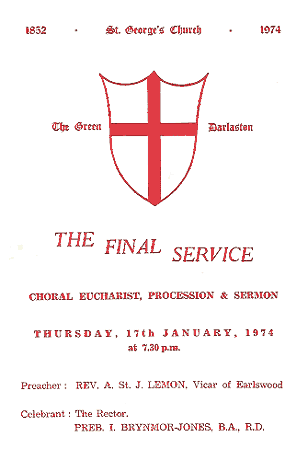
The last service
booklet. Courtesy of John and Christine Ashmore. |
|
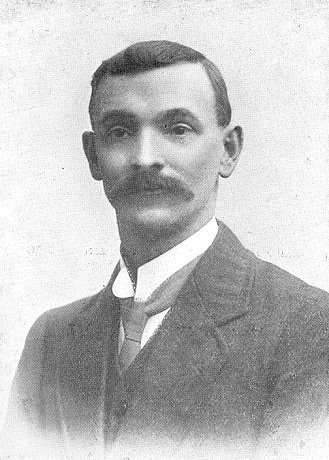
George John Garrington. |
|
|
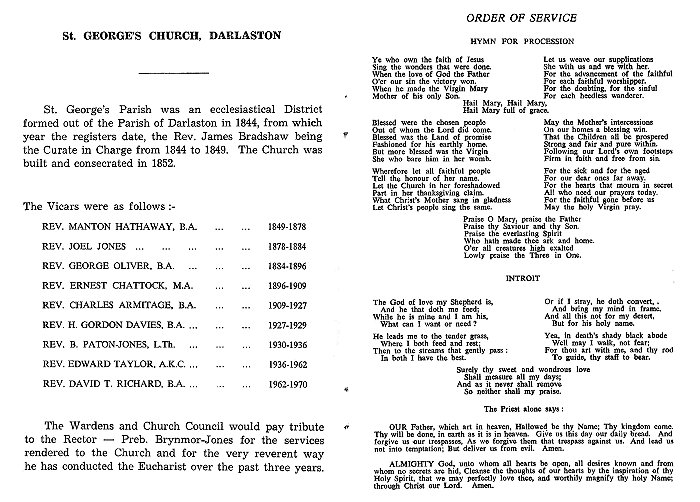
The inside of the last service
booklet. Courtesy of John and Christine Ashmore. |
| In the 1960s and early 1970s the
congregation dwindled, as it did in many other churches. The upkeep of the church and buildings was too much for
the small number of worshippers to bear, and so closure
was inevitable.
The last service was held on 17th January 1974,
and demolition took place in March 1975. |

The three stained glass
windows above the alter. The one on the right
was dedicated to the memory of Samuel Rubery. |
|
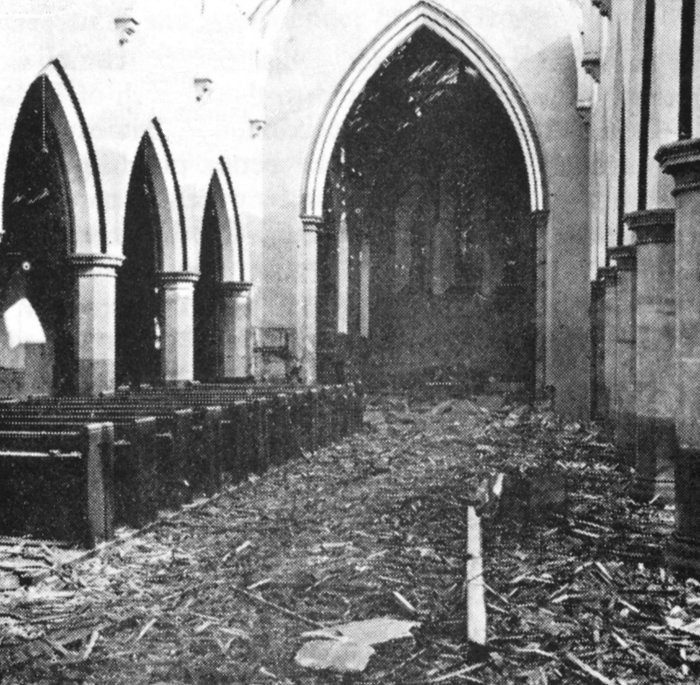
The church in the early
stages of demolition. |
|
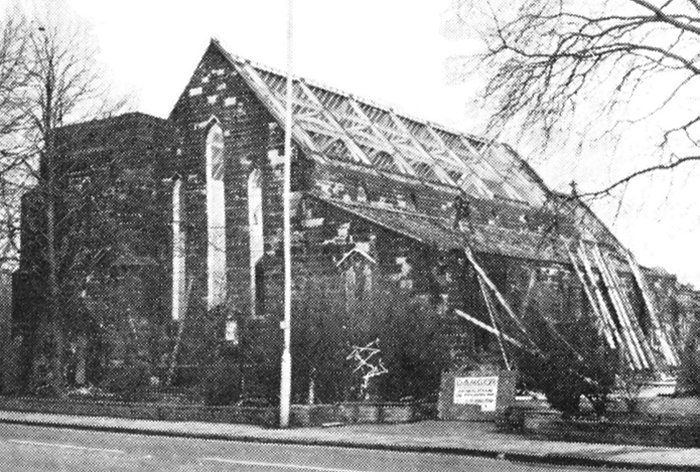
The church during
demolition. |
|
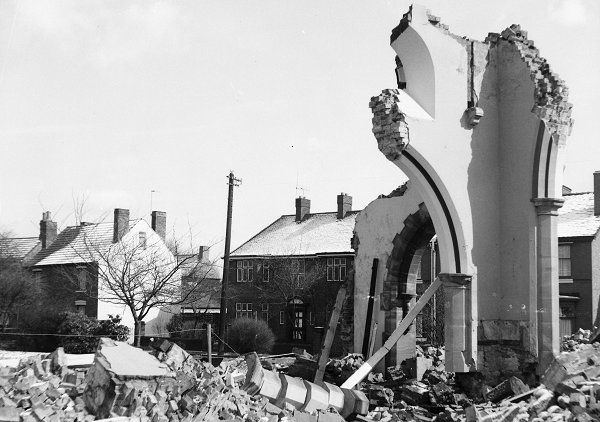
The last remnants of the
building. In the centre background is the later
vicarage, now demolished. Courtesy of Howard Madeley. |
| |
|
View some photographs
of the church |
 |
| |
|
|
Many items from the church were
saved, some of which remained in the town. The font and
the alter crosses and candlesticks were moved to St.
Lawrence's Church, the lady alter went to St. Lawrence's
parish hall, the oak choir stalls were given to All
Saints Church at Moxley, and the children's alter went
to St. Christopher's, at Rough Hay. The organ went to a
church in Norfolk, the stations of the cross went to a
church in Tipton, and the main alter was kept for use in
another church in the Lichfield Diocese.
|
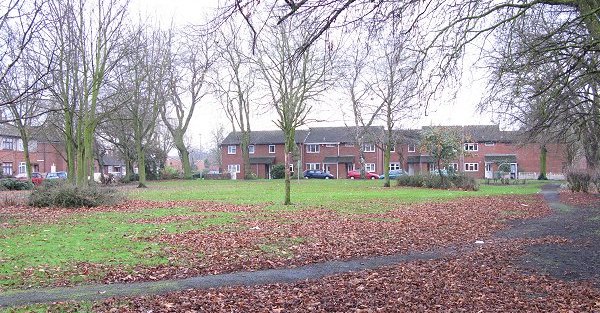
A view of the garden of rest from
December 2007.
 |
Return to
the
previous page |
|